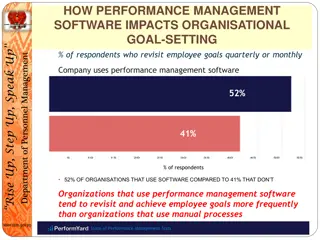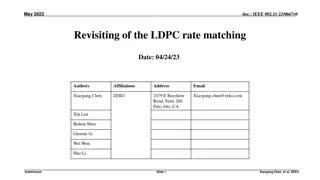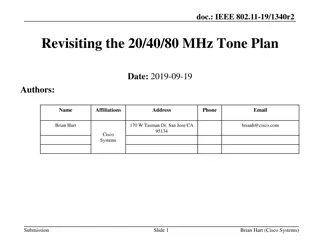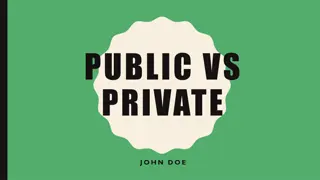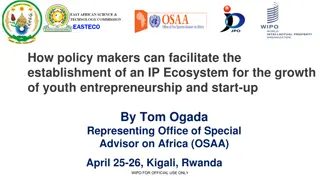Public-Private Partnerships in STI - Revisiting Definitions and Frameworks
Lack of clarity on definitions, legal frameworks, and risk-sharing in PPPs in Science, Technology, and Innovation. Shift towards global challenges, complex knowledge production, and need for joint STI policies. Understanding the complexity factors impacting PPPs and strategic partnerships for addressing high-risk projects with strong governance mechanisms.
Download Presentation

Please find below an Image/Link to download the presentation.
The content on the website is provided AS IS for your information and personal use only. It may not be sold, licensed, or shared on other websites without obtaining consent from the author.If you encounter any issues during the download, it is possible that the publisher has removed the file from their server.
You are allowed to download the files provided on this website for personal or commercial use, subject to the condition that they are used lawfully. All files are the property of their respective owners.
The content on the website is provided AS IS for your information and personal use only. It may not be sold, licensed, or shared on other websites without obtaining consent from the author.
E N D
Presentation Transcript
Public-Private Partnerships in STI Mutual Learning Exercise - ERAC Workshop 30 June 2015 OECD Directorate for Science, Technology and Innovation (STI), Science and Technology Policy Division (STP) Hermann Garden
Public-Private Partnerships in STI -- why re-visiting PPPs? There is still a lack of clarity about: 1. The definition of PPPs; 2. The right legal and policy frameworks; 3. The relationships between affordability, and the sharing of benefits and risks. Shift in innovation policy towards global challenges and impact; Complexity of knowledge production; paucity of low-hanging fruits ; Need to share high financial risks and limited resources; High competition and need to increase the efficiency; Need to jointly develop STI policies. 2
Public-Private Partnerships in STI -- defining PPPs (1/4) PPPs represent contractual or informal agreements (e.g. short- term management and outsourcing contracts, concession contracts and joint ventures) between: public bodies (e.g. governments and their agencies, academia) and the private sector (operator and/or financer) to deliver a service or product. 3
Public-Private Partnerships in STI -- defining PPPs (2/4) PPPs occupy a middle ground between: Traditional public procurement and full private provision; Informal, joint use of resources and licensing, merger. 4
Public-Private Partnerships in STI -- defining PPPs (3/4) Factors that impact the complexity of PPPs: The number, size and legal nature of partners; The scope and objectives of the partnership; The degree of ownership of assets/capital expenditure; The amount of risk carried by partners; The need for transparency and regulatory compliance; The required mechanisms to ensure value for money. 5
Public-Private Partnerships in STI -- defining PPPs (4/4) Strategic Public-Partnerships represent a shift in STI policy from short term contracts with a relatively limited scope to horisontal, multi-stakeholder commitments to address complex challenges. Strategic, challenge-driven, often linked to policy development Long-term vision to link demand-side impulses & supply-side responses Inclusive, horizontal, multi-partner arrangements Otherwise competitive partners bounded by unifying goal Intellectual asset-based (knowledge and talent) Large, shared investments Addressing high risk projects with new financing mechanisms Strong governance mechanisms. 6
Strategic PPPs in STI -- added value to stakeholders Drivers: - Inter-sectorial education - Access to private resources - Raise funds - Show expertise - Scale-up of innovation Drivers: - Access to innovation - Increase competitiveness - Market/ public access - Reduce costs, share risks - New financial resources - Policy development Private Firm Academia Government Drivers: - Make policies more responsive - Increase cost effectiveness - Generate a creative space - Foster smart, regional specialisation 7
Strategic PPPs in STI -- defining the common ground Funding / Investment Knowledge sharing Academia Private Firm Employment Translational science Applied research Technology scale-up Education & Training Production Portfolio decisions IP & marketing Basic research Policy Public perception Funding Product registration Monitoring Public engagement Payers perspective Government 8
Strategic PPPs in STI -- challenges High stakeholder heterogeneity and partnership complexity Fragmented policy instruments Divergence of interests and risk of lack of commitment Partners are often competitive outside the PPP Common ground too narrowly defined need to enlarge Long-term vision versus short-term funding commitments Long implementation phase lag between contract and operation Difficulty of measuring the potential value generated by the PPP. 9
Increasing Efficiency in PPPs in STI -- monitoring and assessment More complex PPPs require a periodic performance evaluation in order to ensure quality, responsiveness and effectiveness. Quality-related performance can be increased through, e.g.: Independent Oversight Conditional Grants Roadmaps and Foresight Early QA implementation - is important to ensure trust, and to identify potential risks, success factors, and value added. - aligns stakeholders and frameworks; quality indicators should match objectives and deliverables. - can impose detailed reporting and quality requirements. - can help identify opportunities for broader application of outputs and reduce risks. 10
Instruments for PPP support -- success factors for strategic PPPs Mutual agreement on objectives, roles, responsibilities and the use of benefits (e.g. ownership of data, intellectual property, financial returns etc.). Mutual Agreement Sharing ownership through equity arrangements increases an actor s relative control over the collaboration, reduces uncertainty in transactions, and effectively deters the opportunistic behavior. Ownership & Commitment Stakeholders join public-private partnerships because of the potential benefits they expect to receive from participation. Shared Benefits 11
Instruments for PPP support -- success factors for strategic PPPs Positive external perception of the programme is important to motivate stakeholders in partnerships and the individual staff. Public engagement is key. Positive Public Image A long-term vision and statement of the importance of work strongly motivates partners and helps top level support. Importance of Work Well-established infrastructure (financial or non- financial) allows partners to work closely, share information, avoid opportunistic behavior. Financing of strategic PPPs is oriented towards the creation of synergy effects on a long-term basis. Resources 12
Special Case of Strategic PPPs -- Conclusions PPPs are a response to complex technical and health challenges. Strategic PPPs are pursued as innovation vehicles to deliver results more effectively and achieve cooperative goals that one individual partner or traditional models could not achieve on their one. Strategic PPPs often have additional foci, e.g.: the design and facilitation of research, operational excellence, the adaption/ modernisation of policy and regulatory frameworks, and the sharing of investment risks and benefits. The complexity of Strategic PPPs requires new criteria for investment, sharing of risks, benefits (e.g. IP rights), monitoring and assessment. Relevant policy domains are, e.g.: Co-operative R&D grants; R&D tax credits for co-operation; Shared research infrastructure; Cluster/network policies. 13



